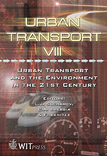Analysis Of The Environmental Impact Of Urban Buses: Application To A Case Study In Lisbon
Price
Free (open access)
Transaction
Volume
60
Pages
10
Published
2002
Size
505 kb
Paper DOI
10.2495/UT020551
Copyright
WIT Press
Author(s)
A.M. Simões, M.C. Coelho, C.M. Silva & T.L. Farias
Abstract
The image related with air pollution associated to urban buses is usually negative. However, quantification of the real contribution of the urban buses to the total pollutant emissions is usually not performed. Therefore. in order to quantify these emissions and compare with the emissions from the additional traffic, a study of the environmental impact of urban buses in a real inner city situation was performed. The study was focused on several routes of CARRIS, the company responsible for exploring the bus routes within the central area of Lisbon, Portugal. Based on the urban buses fleet of CARRIS, the topography of selected routes, the vehicles average speed and transported passengers, the CORINAIR methodology (that was supported by European Environment Agency’s Topic Centre on Air Emissions) was used to predict fuel consumption and CO, NOX, VOC and particles emissions from these urban buses. Experimental measurements of the bus dynamic performances and fuel consumption where performed in order to apply the CORINAIR methodology. Following this task, studies on the influence of several parameters, such as driving behavior, topography of’ the route and type of vehicle related with dynamic and environmental characteristics, were performed. Finally, with [he purpose of predicting the influence of CARRIS fleet on the global emissions (as gram per kilometer and gram per passenger per kilometer) in comparison with the. remaining road traffic as a whole. the same methodology was adopted to calculate the emissions caused by private owned vehicles (along the same routes).
Keywords





